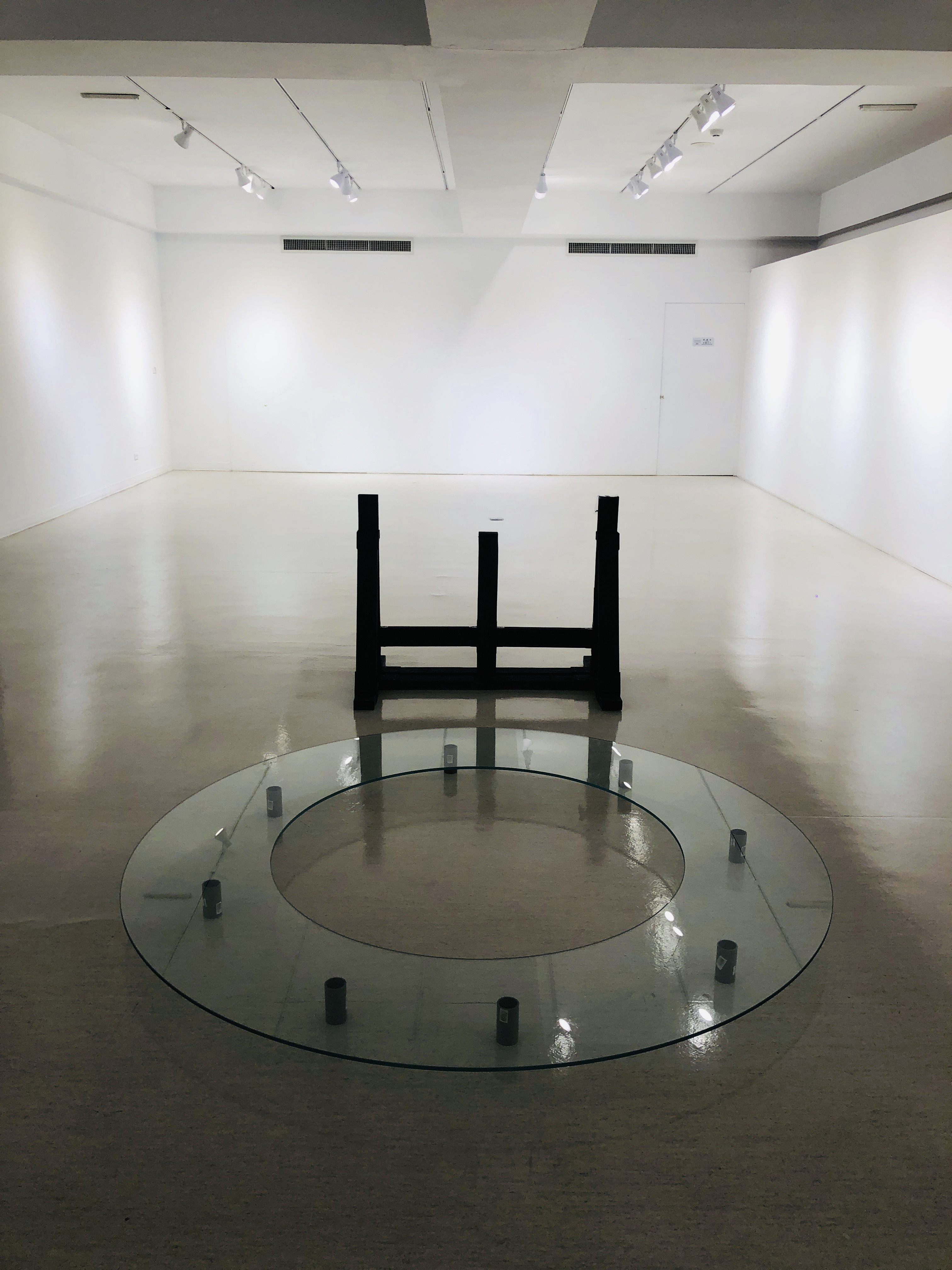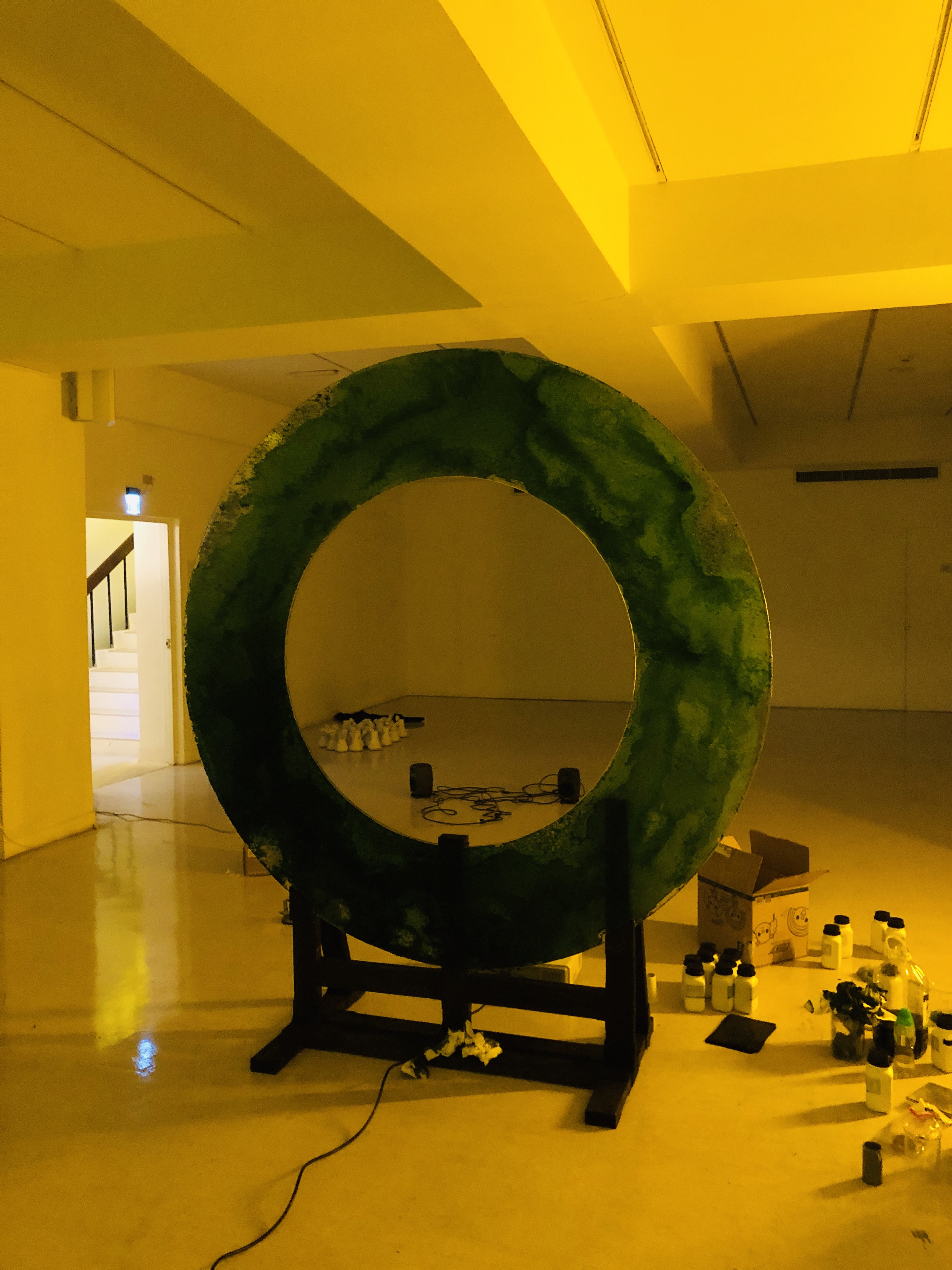量子的編織測光計
The Woven Actinometer for Quantum
考古學家齊格弗里德齊林斯基將「想像的媒體」區分為三類,第一類是「不合時宜的媒體/裝置/機器」,指的
是被設計得太早或太遲的媒體,但終在某一時間點上已然實現;第二類是「構思中的媒體/裝置/機器」,只存於構想之中從未真正付諸實現的媒體;第三類「不可能
的媒體/裝置/機器」是指不能夠實現的媒體機器,卻對我們的思維有重要影響。Archeologist Siegfried Zielinski distinguishes "imagined media" into three categories. The
first category is "untimely media", which
refers to being designed. Media that is too
early or too late, but it has been realized at a
certain point in time; the second category is
"conceptual media", which is only in the con-
cept and has never really been put into prac-
tice Realized media; the third is "impossible
media" refers to media equipment that cannot
be realized, but it has an important impact on
our thinking.

一個科幻的未來機器
草酸鐵鉀是一個古老化學測光計(actinometer)的主要成份,這個測光計同樣也是氰版發明者約翰.赫歇爾在1825年的發明,他創造了「actinometer」這個詞,其字根actino在拉丁文中指的是光束的意思,具體的應用曾有科學家利用結合測光計和氣壓計的 方式,推算出在紅光下,植物透過光合作用將光量子轉換成氧分子的具體數量。
在製造新氰版感光液的過程裡,從冷卻加熱過後的鐵氰化鉀和草酸鐵銨混合液過程中,析出了許多帶有美麗翠綠色的草酸鐵鉀晶 體,這些晶體並不被使用在實驗中的新氰版顯影中。雖然此晶體可以再透過混合醋酸和鐵氰化鉀再被使用來製造普魯士藍,但因 為其相對容易製造和塑形的特性,所以有了收集實驗剩餘的草酸鐵鉀結晶來製作這此展覽中的水晶圓盤裝置的想法。草酸鐵鉀晶 體可以被重複的丟入下次製備的鐵氰化鉀和草酸鐵銨的加熱混合液中,使晶體體積繼續增長,完成的晶體也可以用接近沸騰的蒸 餾水溶解,然後透過冷卻並重新結晶化。在這件展品製作過程中我們將玻璃圓盤的週邊以膠帶封住,再注入製作過程中尚未冷卻 的感光液,使其在玻璃上冷卻並析出草酸鐵鉀晶體,待晶體和玻璃牢固的結合後,再將圓盤立起。晶體在冷卻中結晶化的時間約24 小時,冷卻時間與晶體的物理形狀有關,降溫時間越久所結成的晶體越大。
一篇在OATAO開源論文網站上的論文顯示,在當代一些關於改良偵測光子數量技術的研究,仍然涉及利用這種早期草酸鐵鉀測光 計的原理,且這些研究是在微米尺寸下進行的而不是奈米,這意味著DIY技術涉入的可能性。這些微米結構在流體動力學上的設計 使用了被注入草酸鐵鉀溶液的撓曲微米小管,並將其曝照在紫外線下,透過量測小管內草酸鐵鉀溶液濃度的變化,便能精準量測 這些微米小管所偵測到的光子數量。這篇研究報告的迷人之處在於,類似編織的技巧被利用在微米科學研究中,是為了增加補捉 光子的準確度,以增進學術上科學家對於量子產率的了解。這已足夠使人連想到一個科幻的工藝裝置,以及一個工藝社群和量子科學、材料研究之間的潛在連結。
工藝和科學的合作對我們從來都不是陌生的,著名的約瑟夫·瑪麗·雅卡爾(Joseph Marie Charles)所設計的提花織機,其自動系統利用紋紙上的孔洞排列來控制提花織機的機械運動,促進了人類史上第一台電腦的發明。阿波羅十一號登月時所使用的磁心線 記憶體(core rope memory)利用編織的技巧和磁氣的原理,設計出人類登月艙上的第一代記憶體系統。這些曾經是高科技的古 老媒體都展示了科技和工藝的連結,並曾經巨大的改變了我們的生活。轉身回顧這些歷史,並理解這些媒體如何的曾經或即將形 塑我們的世界,隨著進入由技術和物質所開創的人類世的尾聲,站在「古典現代」巔峰的我們,又如何藉由重新省視過去以重塑我們的未來?
A Futuristic Imaginary Machine
Potassium ferrioxalate is the main chemical component of an old chemical photometer called“actinometer”. This photometer was invented in 1825 by the inventor of cyanotype, John Herschel. The prefix“actin”in Latin means “ray”, and the actinometer is the first scientific instrument named with this prefix. One of many applications of actinometer, in combination with a barometer, is to calculate the amount of photons that plants convert into
In the process of preparing the New Cyanotype solution, many crystals of potassium ferrioxalate with beautiful emerald green color were formed as a byproduct, which were not used in the exposure process at first. Although the crystals can be reused to make Prussian blue by mixing acetic acid and potassium ferricyanide afterwards. Because of its easy production and molding characteristics, the idea of building an installation made of this crystal for this exhibition emerged. The potassium ferrioxalate crystals can be repeatedly recrystallized with the new sensitizer making process. They can also be dissolved in distilled water with ~100ºC and be put into any shape of glass for molding. We taped the periphery of the glass disc and placed it flat, poured the hot New Cyanotype sensi- tizer inside it in a dark place for the crystallization, and then erected the disc vertically after 48 hours to make sure that the crystals would bond to the glass surface perfectly. The cooling duration affects the physical shape of the crystal, the longer the cooling time is, the larger the crystal becomes.
A paper from 2014 found on OATAO, an open access repository, indicates that in some contemporary researches about improving microreactor technology for detecting photon flux (how many photos are initially from the light source) still involves the principle of this ancient actinometer and the potassium ferrioxalate solution. These stud- ies are conducted in the micron scale rather than nano scale, which suggests the possibility of DIY at home. Next is the hydrodynamic design of these microreactors; the potassium ferrioxalate solution is injected into a winding micro-tubes and exposed under ultraviolet rays, and by measuring the change in the concentration of the solution, the photon flux captured by these micro-tubes can be accurately calculated.
What is fascinating is that the weaving-like techniques are employed in this micron scientific research. Since the microreactors are being made for the purpose to improve academic scientists' understanding of quantum yield, this creates an imagination of a fictional craft, a link between the craftsmanship community and quantum science.
The collaboration between craftsmanship and science was never strange to us. Joseph Marie Charles invented an automatic system that uses punch card to control the mechanical movement of a jacquard loom to weave complex textile patterns. This invention facilitated the invention of the first computer in human history. The core rope memory used in Apollo 13 project employed the principle of combining weaving and magnetism, and it became the first generation memory system. Both of these inventions have changed our lives tremendously. Looking back to these history and realizing how our world is built by these technologies, as we are entering the end of an anthro- pocentric era while standing at the pinnacle of "classical modernity", what more could we do to invent our future by altering our review of the past?
production process photos


